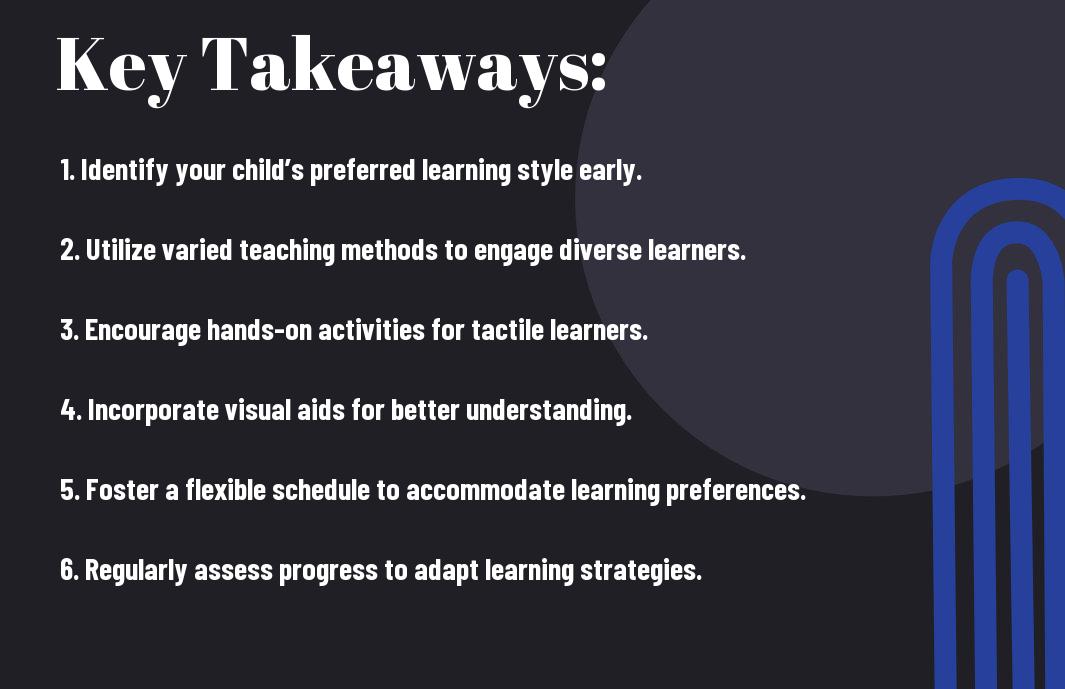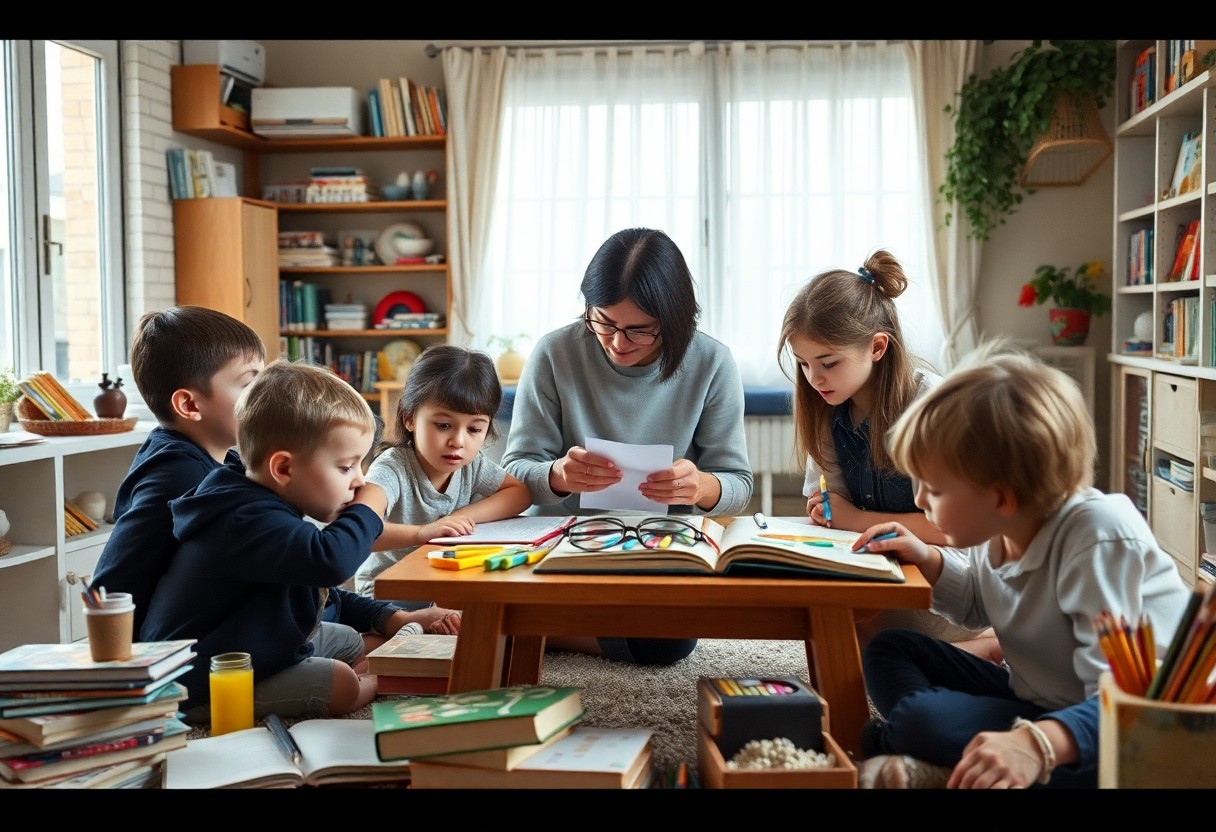Most parents recognize that each child possesses a distinct learning style that can significantly impact their educational journey. As a homeschooling parent, you have the unique opportunity to tailor your teaching methods to suit your child’s individual needs, enhancing their motivation and retention. This approach not only fosters a positive educational experience but also nurtures your child’s self-esteem and love for learning. By understanding and adapting to your child’s learning preferences, you can create an enriching environment that supports their growth and academic success.
Key Takeaways:
- Recognize and adapt to your child’s preferred learning style by incorporating various teaching methods, such as visual aids, hands-on activities, and auditory resources.
- Create a flexible homeschooling environment that allows your child to explore topics at their own pace and interests, fostering a love for learning.
- Regularly assess and adjust your educational approach based on your child’s progress and feedback to ensure they are engaged and thriving academically.

Understanding Learning Styles
Your child’s educational journey can be enriched by understanding their unique learning style. Recognizing how your child processes information enables you to tailor their homeschool environment to better suit their needs. This personalized approach not only fosters a deeper understanding of subjects but also enhances your child’s motivation to learn. When you acknowledge and adapt to your child’s learning style, you create an environment where they feel valued and understood, which can significantly impact their academic performance and emotional well-being.
The Importance of Identifying Learning Styles
Styles of learning can vary significantly from one child to another, and identifying these styles is a key factor in effective homeschooling. When you take the time to pinpoint your child’s learning style, you gain insights into what methods resonate most with them. This understanding can help you design lessons that engage their interests and stimulate their minds, making the learning process more effective and enjoyable. By recognizing and validating their preferred styles, you’re not just teaching them academically but also encouraging their self-confidence and independence as learners.
Overview of Common Learning Styles
Styles of learning can generally be categorized into several distinct types: visual, auditory, and kinesthetic. Visual learners thrive on images and spatial understanding, benefiting from diagrams and charts. Auditory learners retain information better when they hear it, so discussions and lectures may be most effective for them. Kinesthetic learners are hands-on innovators who learn best through activity and movement. Each of these styles presents unique strengths and challenges in the learning process, thus understanding them can aid you in customizing your teaching methods.
Learning about these common styles can provide you with valuable information to enhance your homeschool curriculum. For example, if your child is a visual learner, incorporating colorful visuals and infographics into your lessons can help them absorb information more effectively. Alternatively, auditory learners might benefit from listening to educational podcasts or discussing concepts with you. Lastly, kinesthetic learners may excel when you include physical activities or experiments to reinforce learning. By adapting your approach to align with your child’s preferred style, you can create a more engaging and productive educational experience.

Adapting Curriculum to Fit Learning Styles
Now, as you launch on this rewarding homeschooling journey, it’s crucial to recognize that a one-size-fits-all approach to curriculum often falls short. Every child has a unique learning style, and by adapting your curriculum to cater to these individual preferences, you can enhance their educational experience. One effective方法 is to explore The Art Of Child-Led Learning: A Homeschooling Trend. This approach empowers your child by allowing them to engage with the material in ways that resonate most with them, ultimately leading to greater understanding and retention of knowledge.
Tailoring Lesson Plans
Behind every successful homeschooling experience is a well-tailored lesson plan that aligns with your child’s specific learning style. If your child learns best through visual aids, consider incorporating colorful diagrams, videos, or interactive presentations into your lessons. If they’re more of an auditory learner, you can focus on discussions, podcasts, and audiobooks. By taking the time to customize your lesson plans, you can create a more engaging environment that stimulates your child’s interests and strengths.
Utilizing Diverse Educational Resources
Beside tailoring lesson plans, expanding your resources can also lead to a more comprehensive educational experience. Rely on a variety of materials such as books, online courses, hands-on activities, and community resources to meet your child’s educational needs. For example, if your child enjoys kinesthetic learning, try incorporating hands-on experiments or field trips that allow them to interact with the subject matter directly.
But, in order to truly harness the potential of diverse educational resources, it’s imperative to regularly assess what works best for your child. This includes being attentive to their responses and feedback, so you can adjust your choices effectively. Exploring various tools and approaches not only keeps the learning experience fresh and energizing but also empowers your child to take control of their education. Enthusiasm for learning is often sparked by finding resources that resonate with them, leading to a positive educational journey.

Creating a Supportive Learning Environment
All children thrive in an environment tailored to their individual learning preferences and needs. As a homeschooling parent, you have the flexibility to create a learning space that reflects your child’s unique style. This involves not only physical elements but also an atmosphere that promotes engagement and curiosity. By ensuring that your learning environment is conducive to focus and creativity, you empower your child to explore, learn, and grow in a way that suits them best.
Designating a Learning Space
Among the first steps you can take to foster this supportive environment is to designate a specific learning space in your home. This doesn’t have to be a traditional classroom setup; it can be a cozy nook, a garden spot, or a well-organized desk area. The key is to ensure this space is free from distractions and stocked with the materials that your child loves, whether that be art supplies, books, or technology. Personalization is important; allowing your child to contribute to the design of this space can create a sense of ownership and encourage positive learning experiences.
Encouraging Autonomy and Exploration
Any learning environment should also encourage your child’s autonomy and exploration. By allowing them to make choices about what and how they want to learn, you nurture their natural curiosity and ability to take initiative. This can be as simple as letting them choose a book to read or a project to work on. Providing options and allowing freedom within a structured framework fosters independence that is vital for lifelong learning.
Learning to make choices and explore subjects that interest them helps personalize your child’s educational journey. When you foster an environment where exploration is encouraged, your child is more likely to engage deeply with content that resonates with them. This approach not only enhances knowledge retention but also cultivates a love for learning. Encouraging autonomy means trusting your child’s instincts, which can lead to unexpected opportunities for growth and discovery. In turn, this creates a rich, dynamic learning atmosphere that is responsive to their evolving interests and educational needs.

Strategies for Engaging Different Learning Styles
Despite the increasing awareness of diverse learning styles, many homeschooling parents sometimes struggle to effectively engage their children. Understanding and embracing your child’s unique learning style can lead to more personalized and effective educational experiences. By implementing tailored strategies, you can ensure that your child not only grasps educational concepts but also enjoys the learning process.
Visual Learning Strategies
Strategies that resonate with visual learners often include the use of graphics, charts, and colorful materials. By integrating visuals into your lesson plans, you can capture and maintain your child’s attention. For instance, consider using diagrams to illustrate complex ideas or employing videos that align with the topics you are exploring. You might also encourage your child to create mind maps or sketch notes, which can facilitate a deeper understanding of the material while allowing for creativity.
Auditory Learning Strategies
The path to engaging auditory learners often involves incorporating a mix of discussions, storytelling, and audio resources. As you guide your child through their studies, consider incorporating audiobooks or podcasts that allow them to absorb information through listening. Group discussions and verbal storytelling can also stimulate their learning process, as they thrive when they can narrate what they’ve learned or engage in meaningful conversations about the content.
Further, to enhance the learning experience for auditory learners, you can implement song, rhythm, and even sound associations with concepts. Creating songs or rhymes related to subjects can aid retention and make learning enjoyable. Engaging your child in debates or presentations can also encourage them to articulate their understanding verbally, further solidifying their grasp of the material.
Kinesthetic Learning Strategies
Against the backdrop of traditional educational approaches, kinesthetic learners thrive on hands-on experiences and movement. To cater to their learning preferences, try incorporating activities that encourage physical involvement, such as science experiments, building projects, or interactive games. Consider setting up a learning station where your child can explore concepts through touch, or even a backyard project where they can engage with nature as they learn about biology. This active participation will enhance their ability to connect with the material.
Strategies that enable kinesthetic learners to engage fully can also include taking frequent breaks or incorporating movement into lessons. For instance, if your child is learning about geometry, you might have them physically create shapes with string, or act out historical events you are covering. By linking the academic content with physical activity, you not only promote a better understanding but also foster an active and enjoyable learning environment.
Assessing Progress and Making Adjustments
Keep a consistent focus on monitoring your child’s learning outcomes, as ongoing evaluations are vital in identifying strengths and areas that need improvement. By regularly assessing your child’s progress, you will gain insights into their unique learning style and can tailor your teaching methods accordingly. Utilize a variety of assessment tools, such as quizzes, project-based assignments, or informal conversations that allow you to gauge their comprehension. By staying attuned to their development, you’re better equipped to make necessary adjustments to your curriculum or teaching strategies, ensuring that your child’s educational experience remains engaging and effective.
Ongoing Evaluations
Making ongoing evaluations part of your homeschooling routine can significantly enhance your child’s learning experience. Schedule regular check-ins to discuss what they have learned and how they feel about the material. This not only helps you to track their academic progress but also encourages an open dialogue about their feelings towards their education. Providing them with a space to express their learning challenges promotes a supportive environment where they feel valued. Be prepared to implement adjustments to your teaching style or materials if your assessments reveal that something is not resonating with your child.
Flexibility in Approach
Evaluations should lead the way to incorporating a flexible approach in your homeschooling strategy. If you find that a certain method is not yielding the results you hoped for, don’t hesitate to pivot. The beauty of homeschooling lies in its versatility; you can experiment with different teaching styles, learning resources, and pacing tailored to your child’s needs. For instance, if your child excels in hands-on projects but struggles with written assignments, consider prioritizing experiential learning while gradually introducing writing exercises. Adapt your plans based on their responses and achievements, fostering an educational path that feels tailored and relevant to them.
A flexible approach also allows you to capitalize on your child’s strengths while addressing weaknesses. It’s important to recognize that every child is unique, and their learning journey may not follow a linear path. By being open to change—whether it’s switching curricula or attempting new subjects—you empower your child to flourish academically and personally. This adaptability not only supports their learning but also helps to build a resilient mindset for future challenges.
Building a Community of Support
Not every homeschooling journey is the same; finding a community that understands the unique challenges and triumphs can significantly enhance your experience. Building a support network allows you to share resources, brainstorm ideas, and gain encouragement from others who are navigating similar paths. For tips on Homeschooling Students With Different Learning Styles, consider connecting with local homeschooling co-ops, online forums, or social media groups tailored for homeschoolers. Engaging with like-minded individuals will provide you with valuable insights and foster a sense of belonging that can make your homeschooling journey less isolating.
Connecting with Other Homeschoolers
Homeschoolers are often passionate about their educational philosophy, and connecting with them can open doors to countless opportunities. Join local homeschooling groups in your area or participate in online communities where you can discuss teaching methods and share experiences. These connections not only help you learn from others but also allow your child to socialize with peers who might have similar learning styles or interests. Collaborating on projects, field trips, or group classes can enrich your homeschooling experience and help you discover new techniques your child may respond to.
Utilizing Online Resources and Tools
Support networks are no longer confined to geographical boundaries—many online resources can amplify your homeschooling experience. Websites, blogs, and educational platforms offer lesson plans, activities, and forums where you can interact with fellow educators. With access to digital tools, you can customize learning experiences that suit your child’s unique learning style, whether it’s auditory, visual, or kinesthetic. Platforms that offer interactive content and engaging materials can transform your teaching and make learning more enjoyable. Always seek out reputable sources to ensure you are using resources that align with your educational goals and values.
With the vast array of online resources available, you can explore many innovative teaching tools that can cater to different learning styles. Utilize interactive apps that focus on your child’s strengths, or explore into educational websites that provide gamified learning experiences. The potential of engaging multimedia content can turn lessons into adventures, capturing the attention of your child while ensuring they grasp vital concepts. These platforms can serve as lifelines for families embracing unique learning styles as they allow you to adapt your teaching methods to meet the needs of your child more effectively.
Conclusion
Ultimately, understanding and supporting your child’s unique learning style is a pivotal aspect of effective homeschooling. By recognizing the distinct preferences and strengths of your child, you can tailor your educational approach to foster a more engaging and productive learning environment. This means integrating a variety of teaching methods, resources, and activities that resonate with your child’s natural inclinations. Whether your child thrives through visual aids, hands-on experiences, or auditory lessons, taking the time to explore and implement these styles will encourage not only academic success but also a lifelong love for learning.
As you navigate your homeschooling journey, remain adaptable and attentive to your child’s evolving needs. Keep open lines of communication to discuss what works for them and what might need adjustment. By being responsive and flexible in your teaching strategies, you set a solid foundation for your child’s educational growth. Supporting your child in a way that aligns with their individual learning style is not just about achieving grades; it is about nurturing their confidence and independence as learners. Embrace this opportunity to cultivate a rich, personalized educational experience that respects and celebrates your child’s uniqueness.
FAQ
Q: How can I identify my child’s unique learning style as a homeschooling parent?
A: Identifying your child’s learning style involves observing how they engage with new information. You can utilize various assessments, such as learning style quizzes or questionnaires, to gain insights. Pay attention to how they prefer to learn: are they more visual, auditory, or kinesthetic learners? For instance, visual learners might benefit from diagrams and charts, while auditory learners may excel with discussions and listening activities. Engaging your child in conversations about their preferences can also provide valuable information.
Q: What strategies can I implement to adapt my homeschooling approach to my child’s learning style?
A: Once you’ve identified your child’s learning style, you can tailor your teaching methods accordingly. For visual learners, consider incorporating videos and graphic organizers into your lessons. For auditory learners, reading aloud, storytelling, and discussions can be effective. Kinesthetic learners, on the other hand, may benefit from hands-on activities, experiments, and movement-based learning. It’s also valuable to mix methods, providing a balanced approach that keeps your child engaged and motivated.
Q: How can I keep my child motivated while accommodating their learning style in a homeschooling environment?
A: Motivation can be fostered by creating a learning environment that is both supportive and engaging. Set up a routine that allows for flexibility, enabling your child to explore topics that interest them within their learning style framework. Incorporating games, projects, and real-world applications of concepts can also enhance motivation. Regularly discussing progress and celebrating achievements, no matter how small, can help your child feel valued and excited about their learning journey.

